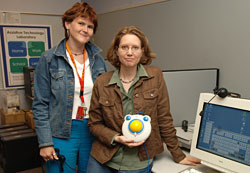Inside Iowa State
Inside ArchivesSubmit newsSend news for Inside to inside@iastate.edu, or call (515) 294-7065. See publication dates, deadlines. About InsideInside Iowa State, a newspaper for faculty and staff, is published by the Office of University Relations. |
June 10, 2005 by Diana Pounds JORDY glasses look like small binoculars. Put them on and you'll be able to spot an ant on the wall across the room. You'll also look a bit like LeVar Burton's visored Star Trek character Geordi, who inspired the name for the glasses.  Corinne Holtz (left) and Janea Triplett in the Assistive Technology Lab This summer, the glasses are helping an Iowa State student with low vision see what her classmates see as their professor lectures and jots on the whiteboard at the front of class. The glasses use tiny cameras to magnify images as much as 30 times and project the results onto the student's eyes. They're on loan to the student from Iowa State's Assistive Technology Lab -- a lab that helps people with low vision, paralysis, poor motor skills, cognitive difficulties and various other disabilities to stay in school or on the job. The lab, in 138 Durham Center, was created through a partnership between Iowa State and the Iowa Vocational Rehabilitation Service in 2004. Serving both the Iowa State community and the state of Iowa, it's the only lab of its kind in the state. Lab coordinator Corinne Holtz, who earned an undergraduate degree in mechanical engineering from Iowa State and a graduate degree in biomedical rehabilitation from University of Michigan, returned to Iowa State in May to lead the Assistive Technology Lab. While she has only been on the job a few weeks, she brings several years of experience in the assistive technology field, working at the University of Oklahoma and for the state of Alabama. And she also brings to clients the empathy of one who has been there. Holtz had been working in rehabilitation for about six years when she suddenly found herself in the same nightmare as many of her clients -- the victim of a catastrophe that robbed her of livelihood and threatened her future. In 2002, at age 30, Holtz suffered a severe stroke that put her in a wheelchair. Doctors told she would never walk or go back to work. Three years later, after her own stint in rehabilitation, Holtz is back to work, without the use of her left hand, but with new insight into those she helps ("its very valuable being on the other side") and renewed confidence in the high-tech devices she touts ("technology can be the tool to get people back to life"). Among assistive technologies are tools that magnify book pages onto computer screens, turn paper copies into Braille, and allow you to talk to your computer ... or your computer to talk to you. There are several mouse alternatives that allow people to direct cursors by moving their heads, their pupils, even their feet. A popular technology on campus is the Kurzweil software, which reads scanned text aloud while highlighting the words on a computer screen. This technology is useful to those with poor vision as well as students who have learning disabilities, Holtz said. Holtz and graduate assistant Janea Triplett spend much of their time making office calls or house calls around campus and the state to match clients with useful technologies. "We work hard to keep our equipment portable so we can take it to people," Holtz said. Visiting clients where they work or live is important, she added, citing the example of one woman who wanted to use voice recognition software on her computer. The home visit turned up eight dogs, whose barking confused the software, until Holtz made the adjustments. The Assistive Technology Lab gets its clients through referrals from university and state officials. ISU Disability Resources refers Iowa State students . (Approximately 100 ISU students have checked out assistive technologies on campus for summer classes.) ISU Human Resources refers faculty and staff. State vocational rehabilitation counselors refer other Iowans. The partnership between Iowa State and Iowa Vocational Resources is working well, says Vocational Rehabilitation administrator Stephen Wooderson. Individuals with disabilities have "some of the best minds in the state solving barriers to their employment opportunities." In her first few months on the job, Holtz is working to get the word out on the assistive technology lab and garner more clients. "There are technology options for even the most severely impaired," she said. "And there's no bigger thrill than helping someone keep a job or go to school." She added that many assistive technologies turn out to be useful for everyone. Even those who aren't in wheelchairs like the convenience of curb cuts, she pointed out. "Assistive technology is an electronic curb cut." |
SummaryOver-sized trackballs, talking computers, and text magnifiers are just a few of the technological wonders Corinne Holtz (left) and Janea Triplett use to help people stay in school or on the job. Holtz, coordinator of the Assistive Technology Lab, and graduate assistant Janea Triplett help clients both on campus and throughout the state. Quote"There's no bigger thrill than helping someone keep a job or go to school." Corinne Holtz, coordinator, Assistive Technology Lab |